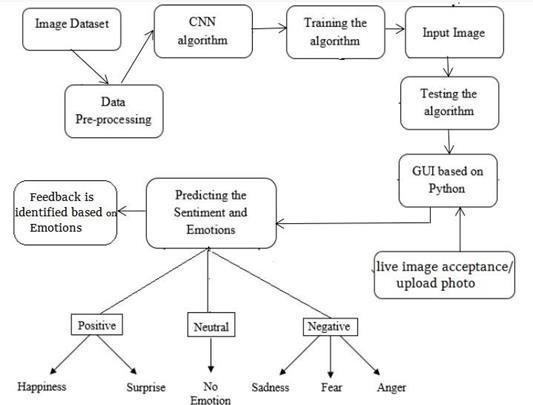Human Emotion Detection for Customer Feedback & Food Classifier
Ayesha Samreen 1 , Srividya M.S 21PG student, Department of Computer Science & Engineering, RV College of Engineering, Bengaluru-560059, India
2Assistant Professor, Department of Computer Science & Engineering, RV College of Engineering, Bengaluru560059, India
***
Abstract - This study analyses the level to which hotel employees are aware of their facial expression/emotion recognition abilities in interacting with customers. As a signof satisfaction and service quality delivered, facial expressions and emotions may have significant implications. The results show that a significant proportion of hotel employees are not fully aware of their facial expression/emotion recognition abilities and that many of them tend to engorge their abilities. This study has important implications in terms of employee efforts put into tasks (such as effort and concentration), selfdevelopment and training, and employee risk-taking behavior in their service encounters. In addition, Food Recommendation based on Emotion Analysis is proposed. An IoT device which first detects the human emotion and then using its artificial intelligence and pretrained images, suggests some food items to the customers at that moment. For the functioning purpose, we used a pretrained emotion detection model and tested it on an image pretrained images from Kaggle.
Key Words: emotionrecognition,facialexpressions,etc.
1. INTRODUCTION
Feedbackisavitalpartintheprocessofself-improvement in any service sector. This study computes hotel and restaurant service sector. In the conventional model, feedbackiscollectedbymeansofquestionnaires(whether manualordigital),andthroughonlinescreensorkiosks.The model displays various delicacy messages related to the customersoverallexperienceoftheservice.
Thisproposedapplicationcanbetechnologicallyadvanced by incorporating digital video cameras to capture the mood/emotion of the customers at various key strategic places within the vicinity of the particular hotel or restaurant outlet and by using artificial intelligence and machine learning to extract frames from the continuous videostreamtorecordtheexactemotionexpressedbythe customer with respect to and in reaction to the various servicesofferedbythesolicitingorganization.
These frames which includes emotions displayed by the consumer is passed through various established human emotiondetectionalgorithmstoextracttheexactfeelingfelt by customer in response to the service efficiency of the serviceprovided.
as“pleaseratetheambienceofthehotelwithrespecttoyour experience”or“pleaseindicatethroughagesturehowyou feltaboutthefood”.Whentheresponseisrecorded,based ontheintensityofthefeelingintheuser,thealgorithmmay classifytheresponseinto“excellent“,“outstanding”“happy”, “notsatisfactory“etc.
This system thus delivers the customer feedback to the service-provider organization, which can then use the information to take corrective measures to improve the qualityofservicetotheendcustomer.
Between food and mood apparently there exists a relationship,variousthingslikeeatingfoodsandthinkingor reactingetc.Foodsandemotionsaretwodifferententities which differs from person to person still interconnected. Emotions play an important role in food choice. Studies showsthatfoodspreciselyraisethebrainneurotransmitter systemthathavethegreater effectsonmood.Thus,foodcan impactourmoodandmoodcanimpactourfood.Foodand emotionareroutineandlogicalcomponentsofourlivesthat isalluringtheydon’tgetconfinetogether.Eventhough,there aremanyresearchonofeffectandcauseoffoodandmood relation such as, brain chemicals, neurotransmitters like serotonin, dopamine and acetylcholine can be influenced by eatenandalsovariationsinbloodsugarlevelsareinfluenced bywhatweeat.Healthyfoods,suchasvegetables,fruits,fish, nuts,seeds,helptopromotebeingcheerful,satisfactionand happiness.Fewotherfoodscanincrease negativefeelings, suchasfrustration,anger,tension,anxiety.Sad:Chocolate, tea, coffee, nuts peanuts, cashew, almonds and walnuts. Angry Tea, coffee, light food like chips, waffles Fear Eggs, nuts, turmeric Disgust Water. For Surprise: water, any availablechilleddrink.Shownintable1.
2. LITERATURE SURVEY
[1] Thissystemproposessentimentanalysismodelbasedon images.Pretrainedmodels(VGG-19,DenseNet121,and ResNet50V2) are compared to predict the sentiments frompictures.Theperformanceofthemodelisimproved byfreezingtheinitiallayersandunfreezingpartofthe model.Overfittingeffectisbeenreducedbyadditionof layers like dropout, batch normalization, and weight regularizationlayersinturnhelpedtopredictsentiments from the database. With DenseNet121 model 0.89 accuracyisobtainedforimagesentimentanalysis.
[2] Thisresearchworkusessocialmediaplatforms,whichis theeasiestwaytoexpressemotionspertainingtoany © 2023, IRJET | Impact Factor value: 8.226 | ISO 9001:2008 Certified Journal | Page534
Forinstance,whenauserpassesinfrontofsuchacameracum-displaydevice,thedevicemaydisplayamessagesuch

occasion and expressing their feelings through social mediaisbyuploadingpictures.Basedontheemotionsin picture they are classified into positive, negative and neutral. This classification is used in automatic tag availableonsocialmediabasedontheavailableimage throughwhichemotionsandsentimentsofpersoncanbe found by Natural language processing (NLP). Two pretrainedandonecustommodelareusedcomparison andtopredicttheemotions.Betterresultsareshownin custommodelandbyusingwebcamera.
[3] Thisresearchstudyisbasedonthefacialexpressionof the person, there emotions and sentiment are found which is conducted with available database using MATLAB.Gaussianfilteringisusedtoremovethenoise in the image, canny is used find out heavy edges, geometric ratios remove errors which increases the performanceofimageprocessing.Theexpressionssuch happy,sad,angry,confusedetc.areclassifiedbasedthe sentimentrecognition.
[4] Inthisstudy,ConvolutionalNeuralNetworksisusedto determinedifferentemotionslikefear,happy,angry,sad, surprise etc. This type of classification helps in application where automatic tag predictor, usually in social media where in the sentiment of person is understood based on their emotions. Two pretrained modelarecomparedandaccuraciesofimagesentiment isdetermined.Firstsentimentisdeterminedandthen emotionispredictedwhichdescribeshappy,sad,fear, surpriseornoemotionsetc.
[5] This study aims at improving signal to noise ratio of seismic data by using median filtering, mean filtering whichhasyieldedtohighsignaltonoiserationandput forwardsConvolutionalneuralnetworknoisereduction framework.PresentsdeeplearningConvolutionalneural networkbasedonfaultnoisesuppressionmethodwhich resultsinhighperformance.Thenetworkcomprisesof input layer, convolution layer, activation layer, normalization layer and output layer. The usage of residual learning, RELU function, and batch normalizationhasimproved accuracy FD-Netmodel and preservingtheoriginaldatasetsandhighsignaltonoise ratio and retains fault information pertaining to the image.
[6] Thisprojectreportsasewingdefectdetectionmethod basedonCNNwithper-trainedVGG-16tofindbroken stitchfromapictureofasewingoperation.Theefficacy of 92.3% was obtained, determined with the set of sewing,normalandrotatedimages.Inordertoreduce the computing time, computing devices and deep learninglibrarieswereanalyzed.Theresultconfirmsthe usefulness in manufacturing technology for garment production.
[7] Themainaimofthisworkisfoundaalternativemethod fortheconventional poolingmethodi.e.,combpoollayer consists of three architectures. It’s observed that,
addition of arithmetic means and maximum as a combinationasyieldedbetterresults.Thecombination of Sugeno integral had an improved performance. Do Sugeno integral obtains good results when combined with other functions. Since positive results were obtained through the generalization of the Sugeno integral, performance of models which include the Choquetintegralandgeneralizationsasacombpoollayer were tested and also combpool is used in modern architectures.
[8] Thisworkpresents,detectionoffoodspoilagefromthe production stage to consumption stage. Freshness of fruit is detected by computer vision-based technique whichusesdeeplearningwithCNN.Laterthemodelis analyzedwithavailabledatasetwithfreshfruitsimages androttenandclassifiedfromKaggle.
[9] This paper presents larger value of analysis on facial responses.Whereineyebrowraises,sad,happy,disgust, positiveandnegativeexpressionsweremeasuredframe by frame basis and mapped with ad liking and brand purchase and effectiveness is measured. A model has been built to predict the emotional responses; results showedhighlikingscores.Andalso,onemoremodelhas beencreatedforpredictingchangesinintentbasedon automatic facial responses, results show good effectivenessofthemodel.Theworktestedinthispaper isforshort-termpurchasingdecisionlikechocolate.This approachcanbecombinedwithcontentanalysisaudio andvisualads.
[10]This study presents various problems related to sentimentanalysis.Thetechniquesusedisdividedinto machinelearning,lexicon-based,andhybridapproaches. sentiment analysis based on machine learning is classifiedsupervised,unsupervised,anddeepmachine learning techniques. Social network post and reviews which is in the form of textual data is analyzed in decision making process based on their emotional behavior and are classified preprocessing, feature extraction,andclassificationorclustering.Allthethree techniques were applied for sentiment analysis are compared;outcomehadhighaccuracyrate.
[11]This study exhibits the functionality of image preprocessing and augmentation techniques present in HistoCleancanbeimprovedinthefield ofdeeplearning byCNN.HistoCleanisusedasopen-sourcesoftwareto implement image preprocessing techniques, time is saved and there’s transparency and data integrity. HistoClean provides a rapid, strong and reproduced, Without the knowledge of coding. It also saves the running and re- running of scripts The application is createdtominimizeandprocedureinstructionthereby creatinguser-friendlyexperience.
[12]This study proposes a comparison among various sentiment analysis classifiers using three different techniques – machine learning, deep learning, andan

evolutionary approach called EvoMSA. Comparison is donebydevelopingtwocorporaofexpressionsintothe programmingdomain,whichdeterminestheemotional stateofstudentregardingteachers,exams,homework, and academic projects. A corpus called sentiTEXT has polarityi.e.,positiveandnegativelabels,whileacorpus called eduSERE has positive and negative learningcenteredemotionslikesad,happy,exhausted, excited, bored, and frustrated labels. Comparing the three techniques, its concluded that evolutionary algorithm (EvoMSA) generated better results for corpus sentiTEXT=93%,andcorpuseduSERE=84%accuracy.
[13]Thisworkpresentsainclusivestudyonfacerecognition methods based on deep learning. Deep learning techniquesistotallyappliedonfacerecognitionandhave played vital role in avoiding challenges in FR, pose variations, illumination, age, facial expression and heterogeneous face matching. Deep learning methods haveyieldedbetterresultsinprocessingRGB-D,video, andheterogeneousface.
[14]The main aim of this study, A method is created for implementing a fully connected deep neural network andconvolutionalneuralnetworkinferencesystemona FPGA.InCNN,systolicarrayarchitecturepresentalong withparallelprocessingpotentialisused.Algorithmic analysis requires minimum memory for fixed point trainedparameters.resultsshowsthattheforblockover distributedmemorysaves≈62%look-up-tablesforthe DNN, and for distributed over block. Memory saves ≈30%BRAMfortheLeNet-5CNNunit.Thisstudygives intuitionfordevelopingFPGA-baseddigitalsystemsfor applicationsrequiringDNNandCNN.
[15]Different types of Machine Learning and depth learning methods are used in Sentiment Analysis like Support VectorMachines,NB,HaarCascade,LBPH,CNN,etc.This as lead in hotels to express their opinion on the food, ambience,etc.whichcanbeausefulresourcetoobtain feedback from the Customers. Proposed work determines Sentiment Analysis pictures pertaining to users along with their faces from the hotel reviews revealingittohighefficiencyinfindingandclassifying emotionsfromimages.
[16]This work describes textual sentiment analysis along withvisualsentimentanalysisforthegivenimageand classifying as positive or negative or neutral. Visual sentiment analysis can be put together as image classificationusingdeeplearningmethodslikeCNN.But sentiment the captured image is affected by three factors:imagefactor,userfactor,anditemfactor.itemoriented and user-oriented CNN has been developed with the interchange of image features with specific expressions of users. Results shows that images from restaurant have been more effective in classifying the sentiments.
[17]This paper proposes, sentiment analysis is classified basedonthefacialexpressionsandvisualanalysistofind whethertheimageispositiveornegativebasedonthe emotions.Animagesentimentpredictionmodelisbuilt usingCNN.Andthesentimentsareclassifiedefficiently and increases the accuracy of hotel picture posted on socialmedia.Theresultsyieldbestperformanceanalysis ofreviewsfromimagescomparedtonaivebayesinML technique.
[18]Image sentiment ideas are Adjective Noun Pairs i.e., automaticallyfindsthetagsofpicturewhichisusefulin findingtheemotions.Thedeeplearningtechniquesare usedforsentimentanalysis,astheyhavetheabilityto effectivelylearntheimagepolarity.Thispaperproposes aDeepNeuralNetwork,ConvolutionalNeuralNetwork, Region-basedCNNandFastR-CNNwiththesuitableto particularapplicationsinimagesentimentanalysis.
[19]In this study, determines how CNN can be used to predictthevariousemotionslikehappy,surprise,sad, fear, exited, exhausted and neutral. There are several applications which automatically tag predictions for visual data on social media and for understanding emotions.TheyhaveusedVGG16model,ResNetmodel, customized CNN framework with 7 layers, which can predicttheemotionandsentimentofthegivenimage.By using CNN, the prediction was more accurate and efficient.Thetrainedmodelwasusedtofindtheemotion onalivephotobyloadingacapturedimageusingaGUI.
[20]This project describes Sentiment Analysis by facial recognitionusingViola-jonesalgorithmtofindanimage and local binary pattern for expression recognition. Support vector machine is used for classification of expression. Based on the facial expression it can find facialexpressionandtellwhetherthepersonishappy, sad or exited. This framework first finds and read a person face. Later it computes different facial expressions. After finding it classifies the expressions suchsadness,happy,sad,exhaustedetc.Basedonthese frameworksdecidesemotionalstate.
3. IMPLIMENTATION
Theinputtofacialfeaturelocatorisstillimagefromface detector.Theoutputfromfacialfeatureisgiventothefacial featureextractortoextractinterestpointsonmouthandeye. Classification module takes the output of normalized face image as input which contains extracted eye and mouth outlineobtainedfromtheendingmarkerpointsforeyeand mouth outline, which is the output of feature extractor module. The image is ready to classify out of 5 emotions listed.Theemotionlabelledimageisgivenasinputforthe feedback rating, the outputs of the image which matches highest rating is assigned for every class. Later once the threshold is reached, segmented image is given as output. Lastly result recognizer gives the feedback with high accuracy.

The dataset is pre-processed which removes noise and brokendatafromtheavailabledataset.ThenCNNmodelis usedfortrainingpurposewhichpredictstheemotionand sentimentofthepicture.LaterGUIisusedtoloadaspecific pictureorcapturealiveimageontrainedmodelwhichwill predict the emotion depicted by the picture from the classification such as happiness, surprise, sadness, fear, angerandneutral.

• Theemotiondetectorfindsauserimagefromparticular pictureorcapturealiveimageasinput.
• Detector extracts the facial features and then normalizedtofeaturevectors.


• Thenbyusingclassifieruseremotionsareclassifiedinto happiness, surprise, sadness, fear, anger and neutral producedfromatrainingmodel.
• Lastly percentage is calculated for each emotion for moreanalysis.
Validation Process:
Accuracyiscalculatedbyproposedmethodology,emotionsas wellasfooditemsaresuggested.Firstpretrainedmodelare loaded, Next is to move through the entire file set of each emotionlikehappy,sad,etc.usingaforloopandpredicting foreverypictureandcomparingittotheactualemotions.If matchingiffound,acounterisincreasedandthetotalpicture counterisalsoincreasedineveryiteration.Lateraccuracy is calculatedusingbelowformula.

AUTHORS YEAR METHODOLOGY LIMITATIONS
Antoanela, Andrei 2022
DifferentDL methodsfor classification suchasusing VGG-19, ResNet50V2, DenseNet-121
Accuracy achievedVGG-19 =73%, ResNet50V2= 75%,and DenseNet-121, 89%.
Yash Gherkar, ParthGujar
2022 MLanddepth learning methods Cascade, LBPH, CNN,
Resultsshows highefficiencyin findingand classifying emotionsfrom images

Valentino,F., Cenggoro,T
2021 Computervisionbasedtechnique usingCNN.
Freshfruits imagesand rottenand classifiedfrom Kaggle
Viratham Pulsawatdi a,JavierI. QuezadaMarín
Barot,V.,& Gavhane
Estrada,M.L. B., Cabada
2021 Deeplearningby CNNand Histoclean
Suggestsforthe applicationsof deeplearning technologiesin hospitality
Guo,G.,& Zhang,N.
2020 Convolutional NeuralNetwork
2020 Machine learning,deep learning,corpus sentitext, edusere
2019 Deeplearning techniqueson facerecognition
CNNprovides 80%fortesting setand60%for validationtest
Theaccuracyfor corpus sentiTEXT= 93%,andcorpus eduSERE=84% isobtained
Deeplearning methodsyields bestresultsin processingRGB D,video,and heterogeneous face
Ruchika Prakash Nagekar
W.K.,Park, Y.C.,Lee
2022 Naturallanguage processing(NLP) Custommodel andwebcamera providesbetter results
2022 Defectdetection methodbasedon CNNwith pretrainedVGG16
Efficiencyof 92.3%was obtained, determinedwith thesetofsewing, normaland rotatedimages
QuocTuan, Truong, HadyW, Lauw
2017 Sentiment analysisusing CNN
Resultsshows thatimagesfrom restaurantis beenmore effectivein classifyingthe sentiments.

M.M.,S Shivakumar, V.R.sanjay
2022 Visualanalysis usingCNN
Resultsyield best performance analysisof reviewsfrom images comparedto naivebayesin MLtechnique.
Factor value: 8.226
NyoungKim a,Hyun Rim Choi
2015 DNNandCNN inferencesystem onaFPGA
Blockover distributed memorysaves ≈62%look-uptables(LUTs)for theDNN
5. CONCLUSION
Thispaperpresentssolutiontogetproperfeedbackfromthe customers, which helps in proper development of the business.Here,theissueistotakerevieworfeedbackfrom

the customers who visit the place(hotel). Those who are interestedingivingfeedbackregularlytheygiveitbutmajor percentageofpeoplethinkitasawasteoftimesotheywill notgivetherevieworfeedback,sothisprojecthelpsusto getproperfeedbackfrom the customers.Insimple terms we havedevelopedtechniqueinwhichcustomerneednotspend moretimeholdinga penand paperfullingaccordingtotheir wishes we just need a small glimpse of image which the customer will have a look and the camera automatically captures the expression and updates it in the database accordingly. Meaning the question about the particular property e.g., service, cost, food is taken and is analyzed usingthetechnologyandisautoupdatedinthedatabaselike good, excellent, bad. Based the expression the customer gives for the particular asked question by our server. In addition, a new idea to detects human emotion by analyzing the facial images and recommending food. The proposed model also analyzes the emotion and suggest food items whichcanmakeushappierandecstatic.Foodinfluencesthe moodinvariousways.Theresultsofemotionanalysisand food recommendation were accurate and shows how emotiondetectionandfoodsuggestioncangohand-in-hand.
REFERENCES
[1] ChandrasekaranG,AntoanelaN,AndreiG,MonicaC,& Hemanth J. “Visual Sentiment Analysis Using Deep Learning Models with Social Media Data “Applied Sciences(Switzerland)-2022.
[2] Swapnil Sanjay Nagvenkar, Ruchika Prakash Nagekar, TanmayNaik,AmeyKerkar,“Emotiondetectionbased onfacialexpression”(IJCRT)-2022.
[3] AynurSevinç,BuketKaya,AytenGeçmez,“ASentiment Analysis Study on Recognition of Facial Expressions: GaussandCannyMethods”(IEEEI)-2020.
[4] DoshiU,BarotV,&GavhaneS,“Emotiondetectionand sentimentanalysisofstaticimages”(IEEE)-2020.
[5] Gherkar Y, Gujar P, Gaziyani A, & Kadu S, “Sentiment AnalysisofImagesusingMachineLearningTechniques Yash”(ICCDW)-(2022).
[6] KimH,JungWK,ParkYC,LeeJW,&AhnSH,“Broken stitchdetectionmethodforsewingoperationusingCNN feature map and image-processing techniques. Expert SystemswithApplications”(IEEE)-2021.
[7] RodriguezMartinezI,LafuenteJ,SantiagoRHN,Dimuro G P, Herrera F, & Bustince H,” Replacing pooling functions in Convolutional Neural Networks by linear combinationsofincreasingfunctionsNeuralNetworks”. (IEEE)2022.
[8] ValentinoF,CenggoroTW,&PardameanB,“ADesignof Deep Learning Experimentation for Fruit Freshness Detection. IOP Conference Series: Earth and EnvironmentalScience”(IEEE)-2021

[9] D McDuff, R El Kaliouby, J F Cohn and P Picard, “Predictingadlikingandpurchaseintent:Large-scale analysisoffacialresponsestoads”(IEEE)-2015.
[10] Shaha Al-Otaibi and Amal Al-Rasheed, “A Review and Comparative Analysis of Sentiment Analysis Techniques”(Informatica)-2022.
[11] KrisDnMcCombe,StephanieGCraig,AmélieViratham Pulsawatdi, Javier I Quezada-Marín, “Open- source software for histological image pre-processing and augmentation to improve development of robust convolutionalneuralnetworks”(IEEE)-2021.
[12] Estradam MLB, Cabada R Z, Bustillos R O & Graff M,“Opinionminingandemotionrecognitionappliedto learning environments”(Expert Systems with Applications)-2020.
[13] GuoG,&ZhangN,“Asurveyondeeplearning-basedface recognition”. (Computer Vision and Image Understanding)-2019.
[14] Mukhopadhyay A K, Majumder S, & Chakrabarti I. “Systematic realization of a fully connected deep and convolutional neural network architecture on a field programmablegatearray”(IEEE)-2022.
[15] Yash Gherkar, Parth Gujar, Siddhi Kadu, “Sentiment Analysis of Images using Machine Learning Techniques” (itmconf)-2022.
[16] QuocTuan, Truong, HadyW, Lauw, “Visual Sentiment Analysis for Review Images with Item Oriented and User-OrientedCNN”(Corpus)-2022.
[17] SShivakumar,VRsanjay,“VisualSentimentClassification ofRestaurantReviewImagesusingDeepConvolutional NeuralNetworks”(Corpus)-2022.
[18] NamitaMittal,DivyaSharma, M.Joshi, “ImageSentiment AnalysisUsingDeepLearning”(Corpus)-2018.
[19] Udit Doshi, Vaibhav Barot, Sachin Gavhane, “Emotion DetectionandSentiment”(IJESC)-2017.
[20] R.NDevendraKumar,Dr.C.Arvind,“FacialExpression RecognitionSystem“SentimentAnalysis”(JourofAdv ResearchinDynamical&ControlSystems)-2017.
